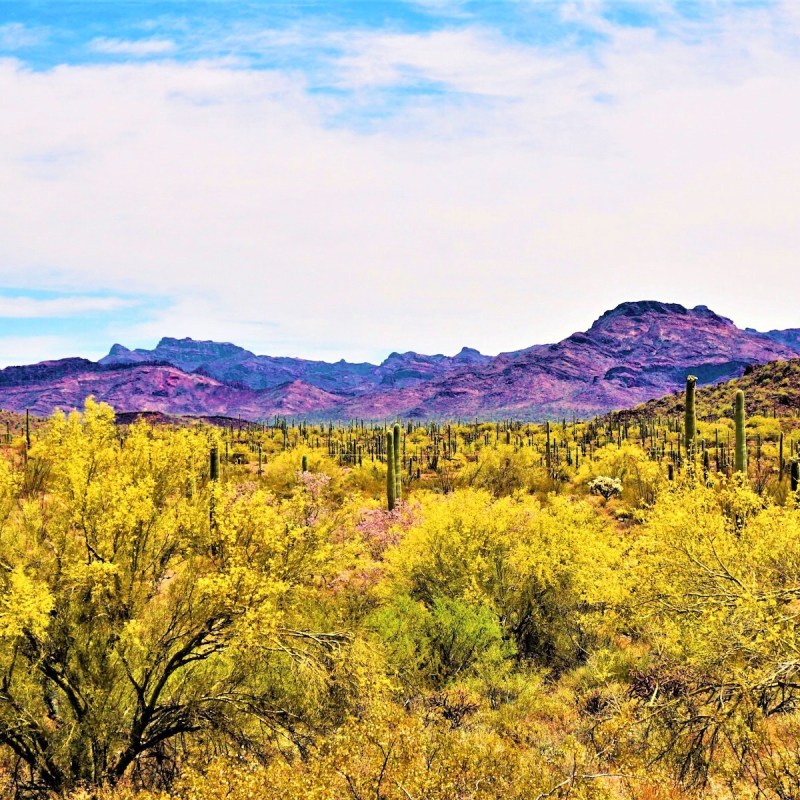
When I experienced fall in the Northeast for the very first time, I fell madly in love. I couldn’t stop dreaming of living with those trees that paint the sky from palettes of gold, red, orange, and yellow. It wasn’t the Northeast, but the home I bought in Seattle had such a special maple tree by the living room balcony. When winter came, though, all its beautiful leaves fell! That’s when, being originally from the tropics, I knew I could not stand the height of winter in such a place for long.
Videos by TravelAwaits
So when at the end of our 8-year full-time RVing phase, my husband and I looked for a place to settle, it had to be farther south. That’s how we discovered the Arizona desert, an environment usually described as barren, waterless, and without vegetation. Considered dull, uninteresting, and even unlivable due to extreme heat or cold, people wonder why others would choose to live in a city like Phoenix. It’s simple, really. We are people who can bear the desert heat in summer better than the winter cold up north. Happily, we have been rewarded with these springtime experiences in the desert that rival fall leaf-peeping in the north.

1. Relishing Simple Things At Home
Springtime is when temperatures are ideal at home. Weatherspark, my favorite forecaster of average temperatures anywhere in the world, says that from March 1 to May 31, highs around Phoenix are 75 to 90 and lows are 55 to 70. Because it is also not humid but dry, it is about as perfect a climate as can be. It’s that time of the year when we turn on neither the air conditioner nor the heater. We simply open the windows to let fresh air in!
It’s somewhat chilly air that wakes you up, giving you perfect mornings with your hot coffee, chocolate, or tea. A little later, it becomes a great time to putz around the garden, go around in a golf cart, and soak up bountiful vitamin D. The nights are also great for cocktails on the patio, another little walk with the dog, or for going out in style and comfort.

2. Seeing Colors Burst Out Everywhere
When we first arrived in the Phoenix area, I thought I would only be seeing drab colors — until I saw the wildflowers paint the desert. Imagine that, at the same time as this happens, all the palo verdes cast yellow into the blue skies. Finally, you will also delight in seeing the diverse cacti bloom with abandon.
Wildflowers
Desert marigold, brittlebush, globemallow, purple lupine, and chuparosa flowers bring the Sonoran Desert alive with the sights and smells of spring. They paint the desert floor in the entire spectrum and carpet the valleys and hillsides. Several regional parks — Estrella, White Tank, and Cave Creek — and state parks — Lost Dutchman, and Picacho Peak — are some we visit during this time. The flowers come out more when winter has been especially wet and snow that has collected in mountain tops produces larger melts. Then a desert super bloom happens.
Palo Verdes
The wildflowers truly transform the desert floor, but that is not what really delights me. At first, I hung on to the notion that I still preferred fall in the Northeast because the color swatches are so huge; they are splashed on the big trees! Well, imagine my delight when I witnessed the Arizona state tree, the desert tree called palos verdes — or “green sticks” — which are normally completely green, turn yellow in spring! Their little yellow blossoms sprout, bloom with abandon, and turn the crowns entirely yellow. Imagine the scene when there are miles of them together. You will appreciate my utter delight, because I am an avid xanthophile (a lover of the color yellow)!
There are two native Arizona Palo Verdes: foothill and blue. They bloom at separate times, so the golden blaze stays around for 2 months, from mid-March to mid-May. The foothill palo verde has more yellowish bark and lighter yellow flowers. Blue palos verdes have twigs, young branches, leaves that are bluish-green, and flowers that border on orange. Both are everywhere: in parking lots, freeway banks, private gardens, and public lands.
The first to bloom are the blues, with the foothills following about 2 to 3 weeks later. Their flowers are both five-petalled, with the banner petal standing out above the plane of the other four. In blues, the banner petal is yellow, sometimes with orange spots. The foothills’ banner petal is white. Once these flowers are pollinated, they produce edible beans.

Cacti
Finally, the iconic Arizona desert cacti, the lovely saguaros that can grow up to 50 feet tall, also bloom in spring. Just go to Saguaro National Park in May and you will see how beautiful it is when they all bloom at the same time! Imagine those green, thorny, and bulky trunks and arms transforming themselves into delicate, flower-bearing trees of the desert. Truly quite a sight!
3. Enjoying Bodies Of Water
Some people react with disbelief when told that Arizona is blessed with 128 lakes and seven major rivers. So endowed, the desert beckons outdoor enthusiasts to swim, hike, raft, ski, and fish, especially during spring. The same snow melts that water the plants guarantee that these bodies of water come alive. In springtime, waterfalls gush, lakes fill, and rivers rise.
Waterfalls
In fact, there are over 15 waterfalls in the state; many are in the Havasu region, in particular, the spectacular Havasu Falls. You must also see the Grand Falls (also known as Chocolate Falls) in the Flagstaff area. She puts on quite a show in spring. Close to where we live, the usually dry one on the Waterfall Drive of the White Tank Mountain Regional Park finally gushes after the rains in February and March.

Lakes
And because the lakes are full, we enjoy the two “steamboats” that ply the two gorgeous lakes all day — the Dolly Steamboat on Canyon Lake and the Desert Belle on Saguaro Lake — offering lunches, cocktails, and dinners on tour. The many beaches come alive around these lakes, especially the great Lake Havasu where the UK’s London Bridge was reconstructed; Apache Lake, which offers motel rooms from where you can literally step on the beaches; and the wonderful playground that Lake Powell has become.
Rivers
There are also seven major rivers in Arizona. The mighty Colorado River is one and Salt, Gila, Verde, Blue, Virgin, and Agua Fria are the others. There is rafting, tubing, and kayaking galore. My husband and I particularly enjoy photographing the wild horses of the Salt River Valley playing in the tributaries of the Gila River. If you’d like to do the same, consider my tips for how to spot the wild horses in Salt River Canyon, Arizona.

4. Going To Markets, Festivals, Ghost Towns, And Ball Fields
Daytimes are perfect so markets come alive at this time in the desert. Many festivals also reemerge, sleeping ghost towns wake up, and empty ball fields fill up with action.
Markets
There always seems to be a farmers market to go to every single day of the week. It is delightful that tropical fruits like avocados, watermelons, and cantaloupes, citrus like oranges, lemons, grapefruit, and limes, and even vegetables like artichokes, palm hearts, and Brussels sprouts are dirt cheap. At this time of the year, I rarely source produce from the groceries.
Festivals
Festivals also abound, from arts and crafts to music, film, wine, and everything in between. Go to the Indian Fair + Market run by one of the best Native American art museums in the country, Heard Museum of Phoenix, the March events at the Phoenix Raceway, or the massive Maricopa County Fair (check dates ahead and plan your visit accordingly). Open-air concerts and drive-in theaters are plentiful.
Ghost Towns
Even ghost towns like Goldfield wake up. Gunfight reenactments reappear, exhibit stagecoaches are rerun, and steam locomotive tours are once again offered after winter closures. There’s nothing like experiencing the Wild Wild West again.
Ball Fields
Even sports teams choose springtime in the desert to train. Come to see your favorite ballplayers practice at the Cactus League Spring Training in ball fields around Phoenix — from the Arizona Diamondbacks and the Chicago Cubs to the Chicago White Sox, Cincinnati Reds, Cleveland Indians, Colorado Rockies, Kansas City Royals, LA Angels, LA Dodgers, Milwaukee Brewers, Oakland Athletics, San Diego Padres, San Francisco Giants, Seattle Mariners, and Texas Rangers. When not in practice, I bet the players thoroughly appreciate springtime in the desert!

5. Visiting National Parks And Monuments
This is the best time to visit the Arizona national parks and monuments that the area is known for: Sedona, Grand Canyon, Walnut Canyon National Monument, Wupatki National Monument, Montezuma Castle National Monument, and Petrified Forest. There are also the less-known ones like Tuzigoot, Sun Crater Volcano, Chiricahua, Navajo, Tonto, Pipe Spring, Agua Fria, Ironwood, Sonora Desert, Hohokam, Rainbow Bridge, and Flagstaff. You’ll be pleased with how they are dotted with springtime flowers. And, in addition to the full blooming of the cacti at Saguaro National Park, the same thing happens at the Organ Pipe Cactus National Monument, where creamy blossoms open during the evenings in spring. In fact, all cacti bloom in spring!
Fall used to be my favorite season, hands down, until we came to the Phoenix area. It is such a paradise in spring. Besides, spring now means more to me than fall: It signals the beginning of life rather than the end of one. We make it a point to be home from all our travels in April and May. That is the time in the desert when it’s as if the sun has unloaded its energy, lending its rays to everything it’s touched, and the color yellow permeates the whole scene without the heat associated with the brightness of it all. I chose the right place to make our home. And it’s the time you should come and visit us!

